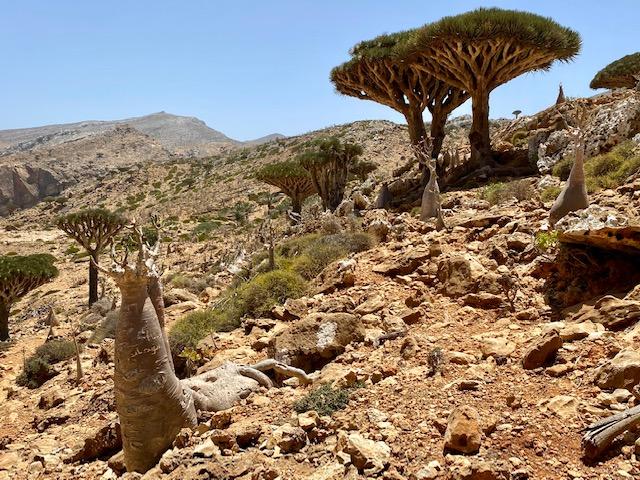Yemen, with its rich tapestry of culture and history, is also home to a remarkable array of trees that play pivotal roles in traditional medicine and cultural practices. From ancient healing rituals to sacred ceremonies, Yemen’s trees have woven themselves into the very fabric of its societal norms and health practices. This blog delves into the significance of Yemen’s trees in these domains, exploring their medicinal benefits and cultural importance.
A Historical Perspective: Trees as Pillars of Yemeni Culture
Yemen’s geographical diversity, spanning from arid deserts to lush highlands, has nurtured a variety of trees that have long been integral to the lives of its people. In ancient times, these trees were more than just resources; they were revered for their medicinal properties and their symbolic presence in Yemeni culture.
One of the most prominent examples is the Frankincense tree (Boswellia sacra), which has been cherished for millennia. This tree’s gum, known for its aromatic resin, has been used in religious rituals and traditional medicine. Frankincense, also known as olibanum, has historical significance not only in Yemeni culture but also in ancient civilizations across the Middle East and beyond. Its resin has been burned as incense in temples, and its therapeutic properties have been documented in various ancient texts.
Medicinal Marvels: Trees as Natural Healers
Yemen’s traditional medicine is deeply intertwined with its native trees. The knowledge of medicinal plants and trees has been passed down through generations, with each Yemen tree offering a unique set of benefits. Here are some notable examples:
- Frankincense (Boswellia sacra)
- Medicinal Uses: Frankincense has been used to treat a variety of ailments, including respiratory conditions, digestive issues, and inflammatory diseases. Its resin contains boswellic acids, which are known for their anti-inflammatory and analgesic properties. Traditional healers often use frankincense to prepare tinctures, teas, and salves.
- Cultural Significance: Beyond its medicinal uses, frankincense is considered sacred in many Yemeni cultural practices. It is often burned during religious ceremonies to purify spaces and invoke blessings.
- Myrrh (Commiphora myrrha)
- Medicinal Uses: Like frankincense, myrrh resin has been utilized for its antiseptic and anti-inflammatory qualities. It is commonly used to treat wounds, sore throats, and gastrointestinal issues. Myrrh’s properties are attributed to its essential oils and resins.
- Cultural Significance: Myrrh also holds religious and symbolic importance. It was one of the gifts presented to Jesus by the Magi and continues to be used in various rituals and ceremonies in Yemen.
- Jujube (Ziziphus jujuba)
- Medicinal Uses: The jujube tree, also known as the Chinese date tree, has fruit and leaves that are used in traditional medicine. Its fruit is rich in vitamins and minerals, and it is believed to help with insomnia, anxiety, and digestive problems. The leaves are often used in herbal teas.
- Cultural Significance: The jujube tree is also valued for its resilience and longevity, making it a symbol of health and vitality in Yemeni culture.
- Olive Tree (Olea europaea)
- Medicinal Uses: Olive trees, though not exclusive to Yemen, are significant in Yemeni herbal medicine. Olive oil is used for its anti-inflammatory, antioxidant, and skin-soothing properties. It is commonly used in cooking and as a topical treatment for various skin conditions.
- Cultural Significance: The olive tree is a symbol of peace and prosperity. Its oil is often used in traditional ceremonies and rituals, reflecting its deep-rooted importance in Yemeni life.
- Pomegranate (Punica granatum)
- Medicinal Uses: The pomegranate tree’s fruit, seeds, and peel are used in traditional medicine for their antioxidant and anti-inflammatory properties. Pomegranate juice is believed to improve cardiovascular health and boost the immune system.
- Cultural Significance: In Yemeni culture, pomegranates symbolize fertility and abundance. They are often featured in festive dishes and used in traditional remedies.

Cultural Practices: Trees in Rituals and Traditions
In addition to their medicinal uses, trees hold profound cultural significance in Yemen. They are often featured in traditional ceremonies and daily life:
- Religious Ceremonies: Trees like frankincense and myrrh are integral to religious practices. Their resins are burned in temples and homes to invoke spiritual protection and blessings. These practices reflect the deep spiritual connection between Yemeni people and their natural environment.
- Festivals and Celebrations: Trees also play a role in various festivals. For example, during the harvest season, the pomegranate is celebrated for its symbolic representation of fertility and prosperity. Special dishes and drinks made from pomegranate are prepared and shared among families and communities.
- Daily Life: In rural areas, the use of tree-based remedies is a common practice. Families often grow medicinal trees in their gardens, and traditional healers are consulted for their knowledge of tree-based treatments. This reflects a sustainable and harmonious relationship with nature.
Conservation and Future Outlook
As Yemen faces environmental challenges, including deforestation and climate change, the conservation of its medicinal trees becomes increasingly crucial. Efforts are being made to protect these valuable resources through sustainable practices and awareness programs. Preserving Yemen’s trees not only supports the environment but also ensures the continuation of traditional medicine and cultural practices.
Conclusion
The trees of Yemen are much more than just flora; they are vital components of the country’s traditional medicine and cultural practices. From the sacred frankincense and myrrh to the versatile olive and jujube, these trees provide both physical and symbolic nourishment. Their preservation is essential for maintaining the health of Yemeni communities and honoring the rich cultural heritage they embody. As Yemen navigates modern challenges, the enduring wisdom of its traditional practices offers a valuable blueprint for sustainable living and cultural continuity.
